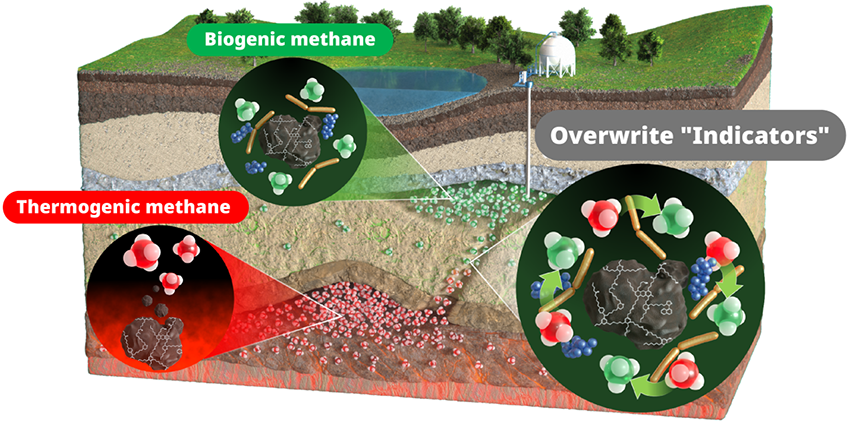Update(MM/DD/YYYY):12/27/2024
Subsurface Microorganisms Disguise the Origin of Natural Gas!?
―New discovery prompting origin review changes future of natural gas deposit exploration―
Researchers) MAYUMI Daisuke, Senior Researcher, SAKATA Susumu, Collaborating Visitors, Research Institute for Geo-Resources and Environment, KAMAGATA Youichi, Invited Senior Researcher, Biomedical Research Institute, TAMAKI Hideyuki, Deputy Director, Research Institute, KATO Souichiro, Chief Senior Researcher, IGARASHI Kensuke, Senior Researcher, SATO Tomoyuki, AIST Postdoctoral Researcher (at the time of the research), Bioproduction Research Institute, MINAGAWA Hideki, Technical Staff (at the time of the research: Methane Hydrate Research Center, Leader, Team), NISHIKAWA Yasunori, (at the time of the research: Methane Hydrate Research Center, Technical Staff), Energy Process Research Institute
Points
- Two types of natural gas exist: biogenic, produced by microorganisms, and thermogenic, generated by underground heat.
- Discovery of subsurface methanogens overwriting the "indicators" of natural gas of thermogenic origin with those of biogenic origin
- This finding encourages a reevaluation of natural gas resource estimates and exploration methods, paving the way for the discovery of new natural gas deposits.

The origins of methane in natural gas deposits and the phenomenon of methanogens overwriting the origin indicators
Background
Natural gas is a clean fossil energy resource compared to oil and coal, accounting for about 24 % of global energy consumption. On the other hand, methane, the main component of natural gas, is also a potent greenhouse gas. Understanding the mechanisms of global methane generation, migration, accumulation, and diffusion is essential not only for accurately assessing natural gas resources, but also for addressing climate change issues.
Methane produced in the subsurface environment can be broadly classified into two types: biogenic, which is produced by microorganisms in relatively shallow formations at subsurface temperatures below 80 °C, and thermogenic, which is produced by thermal decomposition of organic matter deep underground at higher temperatures and pressures. The origin and formation temperature of methane (molecular formula: CH4) can be estimated using the stable isotope signals of carbon and hydrogen (e.g., the ratios of 13C to 12C, and 2H to 1H). These signals have been instrumental in exploring natural gas deposits, such as methane hydrates, and identifying methane gas sources in lakes and rice paddies. However, a critical issue remains unresolved: stable isotope signals of biogenic methane in the subsurface have never been reproduced in laboratory methanogenic cultures, leading to inconsistent interpretation between isotope geochemistry and microbiology.
Summary
Researchers from AIST, in collaboration with Massachusetts Institute of Technology, have discovered that methanogenic archaea ("methanogens") living underground can change the "indicators" of thermogenic natural gas to those of biogenic gas. This could significantly change the information on the origins and reserves of natural gas, raising the possibility of uncovering new natural gas deposits that have previously been overlooked.
Understanding where and how methane, the main component of natural gas, is produced is crucial for assessing global natural gas resources. Until now, "stable isotope signals" have been used as an indicator to distinguish the origin of methane. However, this approach has faced a major problem that has remained unsolved for nearly half a century: the stable isotope signal of biogenic methane produced by methanogens in the subsurface cannot be reproduced in a laboratory methanogen culture.
In this study, researchers developed a high-pressure culture system that can faithfully simulate the underground conditions. Using this system, they achieved a world-first: experimentally replicating the stable isotope signals of biogenic methane produced underground. Furthermore, they uncovered a surprising phenomenon: methanogens can alter the stable isotope signals of coexisting thermogenic methane, effectively overwriting them to mimic those of biogenic methane. This discovery indicates that the quantity of thermogenic methane may have been underestimated, and highlights the need for a significant revision of our understanding about the origins of the natural gas deposits. Consequently, these findings prompt a reevaluation of exploration methods for natural gas deposits, raising the possibility of discovering previously overlooked reserves.
Article information
Journal: Science
Title of paper: Hydrogenotrophic methanogens overwrite isotope signals of subsurface methane
Authors: Daisuke Mayumi*†, Hideyuki Tamaki†, Souichiro Kato†, Kensuke Igarashi†, Ellen Lalk, Yasunori Nishikawa, Hideki Minagawa, Tomoyuki Sato, Shuhei Ono*, Yoichi Kamagata*, and Susumu Sakata*
*Corresponding author
†These authors contributed equally to this work.
DOI: 10.1126/science.ado0126